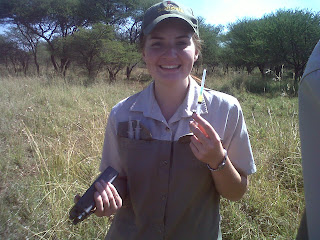Chemical Darting is fun!
On 01 May 2012 we had to dart a few Impala ewes that had to be transferred to one of the farmers farm.
We went into the felt at 10am to start darting. First we drove around trying to locate the ewes in an area that would be easy to dart and move them. When we found them, we set up everything. The transport trailer into which we had to move the Impala after darting them, was parked under a tree in the shade to keep it cool.
 |
| Transporting trailer |
The procedure to follow was, when the ewe was darted with A3080, we would track her with the tracking device placed in the dart to the place where she finally fell down.
When we got to her, the first thing to do was place her in Sternal ( lying on her stomach with her feet folded in underneath her), lifting her head up and pulling the tongue out. Someone had to monitor her to make sure she is still breathing and that her breathing was normal.
Moira or Jeanine would then tag the ear with a specific number tag and use the tag gun. The ewe had to be tagged in her left year and they had to watch out for the veins so that they don’t push the tag through the veins.
While they were busy tagging the ear, I would inject the ewe with Vitamin BCo, Vitamine ease and Dectomax.
We would then load her onto the stretcher and onto the back of the bakkie, still monitoring her, and then move her to the transport trailer. Once the ewe was loaded into the trailer I would inject her with M5050 that was the antidote to reverse the sedative.
After all the Impalas that we darted were loaded into the trailer, we went to the Wild Life Center to load the Impala that was caught the previous day into the trailer.
All and all it was a very fun, yet hot and exhausting day!!

















